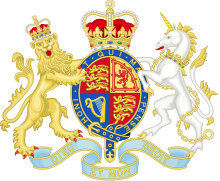
Back الأميرالية البريطانية Arabic Адмиралтейство на Великобритания Bulgarian Amiraliezh (Rouantelezh-Unanet) Breton Almirallat Britànic Catalan Admiralität (Vereinigtes Königreich) German Ναυαρχείο (Ηνωμένο Βασίλειο) Greek Almirantazgo británico Spanish Admiraliteet Estonian Britannian amiraliteetti Finnish Amirauté (Royaume-Uni) French
 | |
| Department overview | |
|---|---|
| Formed | 1707 |
| Preceding Department | |
| Dissolved | 1964 |
| Superseding Department | |
| Jurisdiction | Government of the United Kingdom |
| Headquarters | War Office building Whitehall London |
| Department executive | |
| Parent Department | HM Government |
The Admiralty was a department of the Government of the United Kingdom[1][2] responsible for the command of the Royal Navy until 1964, historically under its titular head, the Lord High Admiral – one of the Great Officers of State. For much of its history, from the early 18th century until its abolition, the role of the Lord High Admiral was almost invariably put "in commission" and exercised by the Lords Commissioner of the Admiralty, who sat on the governing Board of Admiralty, rather than by a single person. The Admiralty was replaced by the Admiralty Board in 1964, as part of the reforms that created the Ministry of Defence and its Navy Department (later Navy Command).[3]
Before the Acts of Union 1707, the Office of the Admiralty and Marine Affairs[4] administered the Royal Navy of the Kingdom of England, which merged with the Royal Scots Navy and then absorbed the responsibilities of the Lord High Admiral of the Kingdom of Scotland with the unification of the Kingdom of Great Britain.[5] The Admiralty was among the most important departments of the British Government, because of the Royal Navy's role in the expansion and maintenance of the English overseas possessions in the 17th century, the British Empire in the 18th century, and subsequently.
The modern Admiralty Board, to which the functions of the Admiralty were transferred in 1964, is a committee of the tri-service Defence Council of the United Kingdom. This Admiralty Board meets only twice a year, and the day-to-day running of the Royal Navy is controlled by a Navy Board (not to be confused with the historic Navy Board). It is common for the various authorities now in charge of the Royal Navy to be referred to as simply 'The Admiralty'.
The title of Lord High Admiral of the United Kingdom was vested in the monarch from 1964 to 2011. The title was awarded to Prince Philip, Duke of Edinburgh by Queen Elizabeth II on his 90th birthday and since his death in 2021 has reverted to the monarch.[6][7] There also continues to be a Vice-Admiral of the United Kingdom and a Rear-Admiral of the United Kingdom, both of which are honorary offices.
- ^ Hamilton, C. I. (3 February 2011). The Making of the Modern Admiralty: British Naval Policy-Making, 1805–1927. Cambridge University Press. p. 56. ISBN 9781139496544.
- ^ Ministry of Defence (2004). The Government's expenditure plans 2004–05 to 2005–06. London: Stationery Office. p. 8. ISBN 9780101621229.
- ^ Archives, The National. "Admiralty, and Ministry of Defence, Navy Department: Correspondence and Papers". discovery.nationalarchives.gov.uk. National Archives, 1660–1976, ADM 1. Retrieved 3 March 2017.
- ^ Knighton, C. S.; Loades, David; Loades, Professor of History David (29 April 2016). Elizabethan Naval Administration. Routledge. p. 8. ISBN 9781317145035.
- ^ Lawrence, Nicholas Blake, Richard (2005). The illustrated companion to Nelson's navy (Paperback ed.). Mechanicsburg, Pa.: Stackpole Books. p. 8. ISBN 9780811732758.
{{cite book}}: CS1 maint: multiple names: authors list (link) - ^ "New title for Duke of Edinburgh as he turns 90, who remains the incumbent". BBC News. BBC. 10 June 2011. Retrieved 10 June 2011.
- ^ "Lord High Admiral - a Freedom of Information request to Royal Navy". WhatDoTheyKnow. 15 June 2021. Retrieved 21 September 2021.